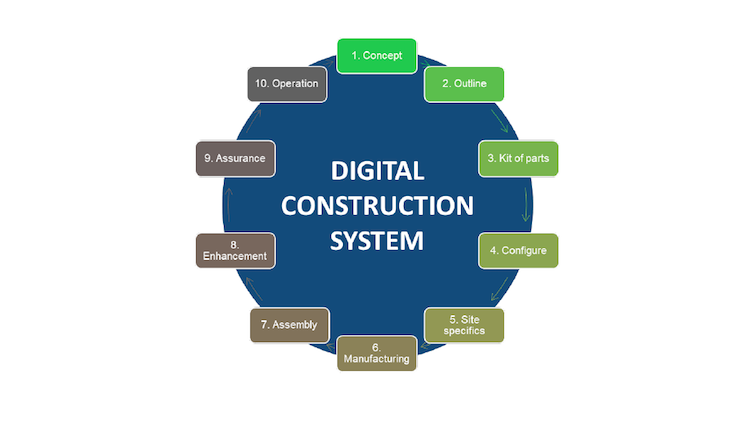
What does four years running the Transforming Construction Challenge teach you? Sam Stacey is the director who has run the Innovate UK-affiliated initiative since its inception in late summer 2018. He will step down at the end of September when the initiative’s funding comes to an end.
The initiative was judged a success, its mission complete, but for Stacey that mission remains a continuing passion.
Stacey’s time with Transforming Construction leads him to state that, through innovation, quality can be improved, material wastage and labour hours can be cut and energy consumption reduced.
To promote this message, he has set up Stacx, a business that will help to enable the continued “revolutionising of construction for the benefit of the environment, the contractor and the investor”.
BIMplus: Tell us more about Stacx
SS: Because there’s such a lot of alignment between what I’ve been doing with Transforming Construction and what I want to do going forward, I’ve been able to synchronise activities, and I’ve spent lots of my spare time developing this new venture.
My conclusion from Transforming Construction is that, roughly speaking, the following are feasible improvements for the industry:
- quality can be vastly improved by a 95% reduction in defects;
- the amount of externally-sourced energy needed to operate a building can be reduced by 75%;
- a 25% reduction in the volume of materials used in constructing a building can be achieved; and
- the number of labour hours needed to construct a building can be cut by 75%.

“Digital solutions are very scalable and represent very good business models. We need to get away from this paradigm of construction, whereby you chuck a load of money at something and you get a one-off result.”
And the mission is all about making that happen.
There are so many stakeholders in construction. You’ve got government: its policy and procurement. You’ve got the contractors and various companies that are involved in delivering projects. And I think the nature of that ecosystem is starting to shift a lot.
And then you’ve got the whole investment community, which is very fired up about investment in green technology and somewhat fired up about investment in other areas related to construction.
I’m interested in smoothing the development of this new ecosystem – it’s exactly what I’ve done for the last four years.
How exactly will you achieve that ‘smoothing’?
It’s helpful to provide a framework for people to understand things. The [‘new’] construction system, the whole project life, can be broken down into these 10 stages:
- concept;
- outline;
- kit of parts;
- configuring the kit of parts;
- site specifics;
- manufacturing;
- assembly;
- enhancement (what one might call the personalisation of a building);
- assurance; and
- operation of the building, including Internet of Things condition-based maintenance.
Via Transforming Construction, I’ve got case studies for nine of those 10.
Scalable digital solutions
Generally speaking, digital solutions are very scalable and represent very good business models. And that’s very appealing: we all need to get away from this paradigm of construction, whereby you chuck a load of money at something and you get a one-off result. We want to, as far as possible, design it once, and then roll it out many, many times. I think it’s amazingly possible to do it.

For those involved in the construction of a building, Stacx has a four-stage process:
- discover the opportunities for the organisation to create buildings in a better way;
- define the targets that will be applicable to the specific situation;
- apply the techniques that need to be employed (broadly speaking from the Transforming Construction portfolio); and
- develop the relationships and networks that need to be implemented to support all that.
I think the exciting thing will be to work with all the different types of organisations (architects and engineers, tier one contractors, subcontractors and clients) and say, “Okay, so this is where you are, this is what you’re capable of, this is where we could get you to; how do we make that happen?”
Bringing in other experts
Stacey describes Stacx as being “primarily me, plus a part-time chief operating officer or programme manager, and a part-time entrepreneur consultant”.
He adds: “It’s then a question of setting up a constellation of partner organisations that I can draw upon as necessary.”
Naturally BIMplus asks if Stacey can name the organisations in that constellation. He confides, off the record, an impressive and intriguing list of those involved in industry change in construction. Confidentiality means they can’t be named at this stage.
On the record, he says: “There are some players in this space that are helping the transformation. They’ve got big capabilities and can provide the backup to what I’m doing. And what I envisage is that we’ll be cross-selling a fair bit.
“For example, if you want a strategy piece, and you want to understand government, Stacx is the organisation that can help you with that. If you want detailed implementation of offsite fabrication strategy or a digital strategy, then Stacx can pull in the expertise [from a business in the ‘constellation’].
BIMplus: Are there specific sectors of the built environment that Stacx will focus on or any specific areas of construction transformation?
SS: I think that will develop organically to a fair degree. Partly Stacx is going to be influenced by my personal enthusiasms, which are architecture and sustainability in the built environment. What that somewhat excludes is linear infrastructure.
What’s the view of the continued potential for construction to transform among political stakeholders and the financial community?
“My vision for the change of the industry is you combine the expertise of people who know the ropes with clever, entrepreneurial disruptors.”
Government is very distracted and being pulled in all sorts of directions. It looks as though there will be some appetite for applications of specific solutions from Transforming Construction and a reasonably good follow-through on the back of what we’ve done with the Construction Playbook and the Transforming Infrastructure Performance: Roadmap to 2030.
In terms of throwing much investment at it, it looks tough – the funding environment we’re in at the moment is virtually unprecedented.
At Transforming Construction, we’ve been vigorously making the case that if you want to get your schools and your hospitals for less money, it would be wise to invest in what we’re doing now.
Construction tends to be caught between two stools: there’s an appetite for innovation that’s market-ready and for the discovery/laboratory phase.
But in that middle area between the two, where you’re dealing with stuff that is at technology readiness level seven, eight or nine, it’s quite hard to find funding.
And that’s where I would be looking to private sector investors to get involved. If you can make a convincing case that that it contributes to the green agenda, there is plenty of money available. Venture capitalists are pretty flush at the moment (maybe not as flush as they were two years ago), but green is a hot topic. And I think it will remain a hot topic, especially if we start seeing really good returns from that.
The mission is to understand that ecosystem and work out how to help it along.
What advice would you give to those who don’t feel sufficiently engaged with the change agenda?
Be aware of the huge potential here. And if you want to know how to do it, it’s not a leap into the dark. We just spent four years and £170m in grant funding and £250m in terms of overall project costs on developing a portfolio of solutions that shows how you make all this work. No one can say, “That’s all very well, but no one’s tried it”. Or, “It looks a bit scary”. Look at the Forge building. Look at what we’ve done on a number of projects: the opportunities are there.
My vision for the change of the industry is you combine the expertise of people who know the ropes with clever, entrepreneurial disruptors, and then you’ve got a really powerful formula.
With the conclusion of Transforming Construction, were you in any way tempted to go back to corporate life?
I believe passionately in these kinds benefits, these kinds of changes and the benefits to society that come from them. What’s the best way to make this happen? I thought of various routes through corporate life, and those routes are going to constrain me in ways that I don’t want to be constrained. So I concluded that I have to go it alone.
I can’t not do this now: I believe in it.
Don’t miss out on BIM and digital construction news: sign up to receive the BIMplus newsletter.
Comments
Comments are closed.















Sam good luck with this new venture but the ‘people and competency’ challenge seems to be missing here? Productivity gains from industrial digitalisation and MMC/DfMA and Value Add can’t be achieved without platform approaches, PLUS comprehensive product data (and related procedure & task datasets), PLUS workforce planning capability, PLUS organisational and supply chain competency management and PLUS performance & competency registers (data of evidence for compliance) underpinned by standards-based data processing for competency management in terms of duties, skills, knowledge and behaviours. The output the Innovate PBBS project I have completed brings new perspectives on work and workforce planning arising from DfMA